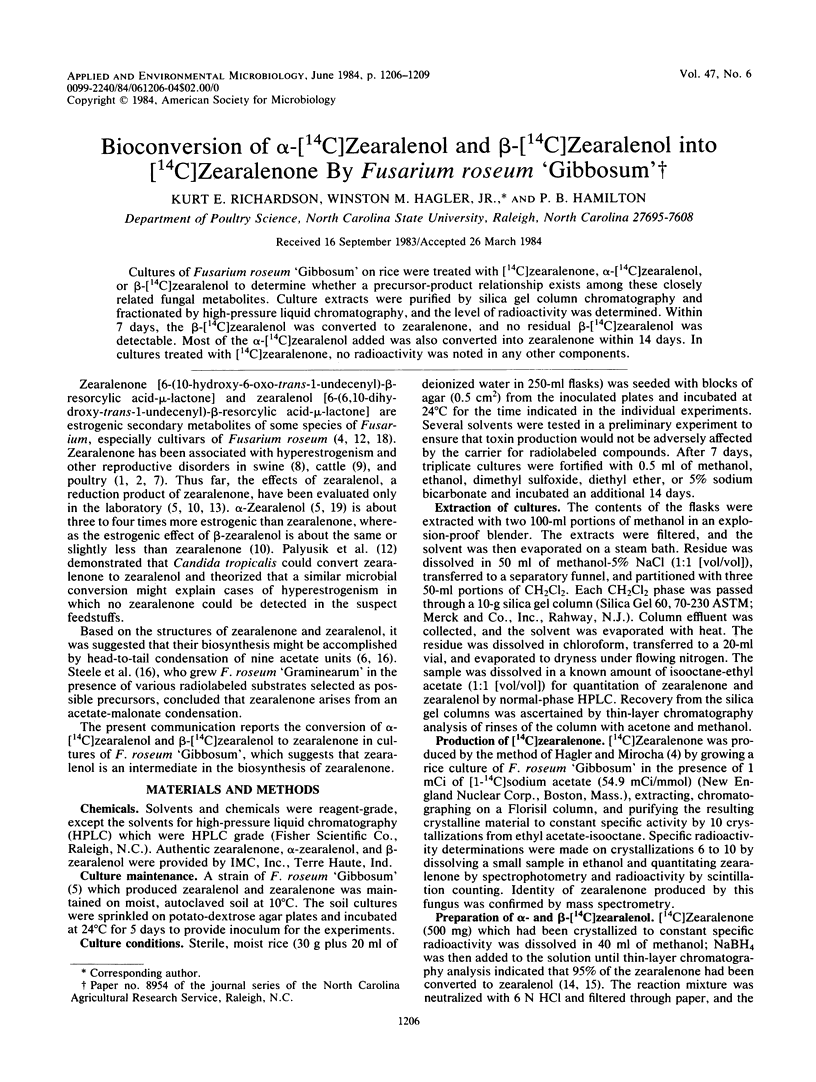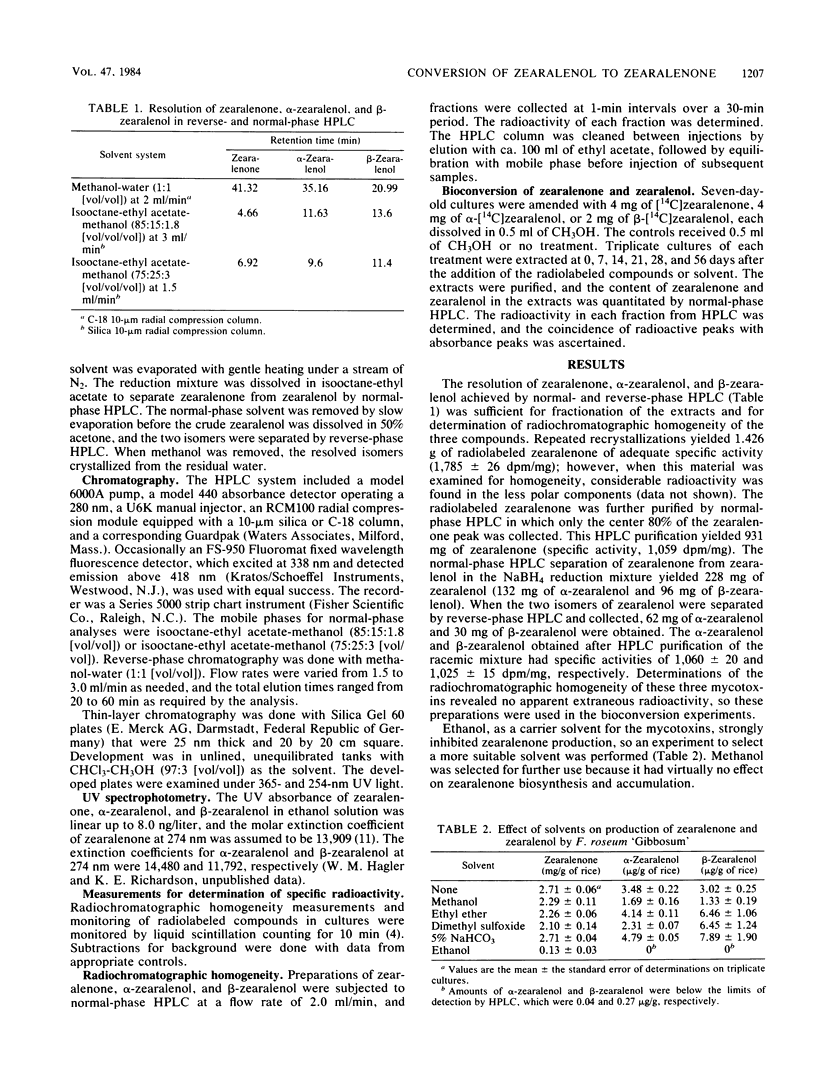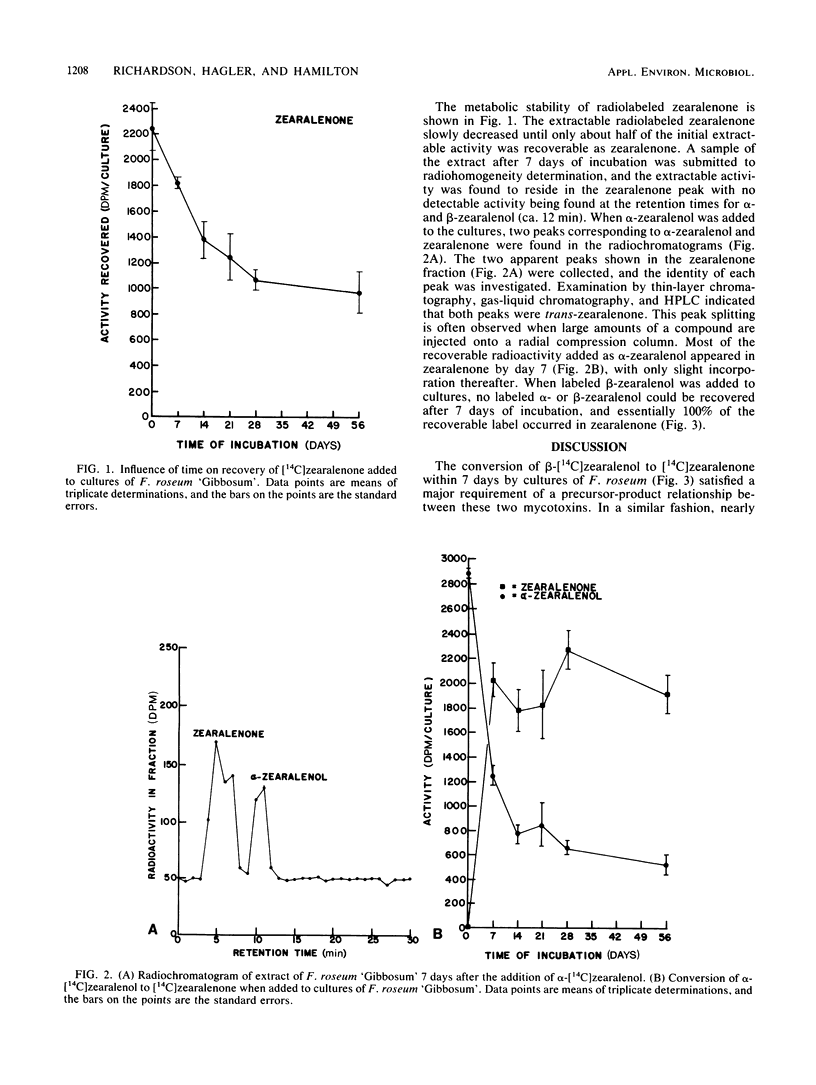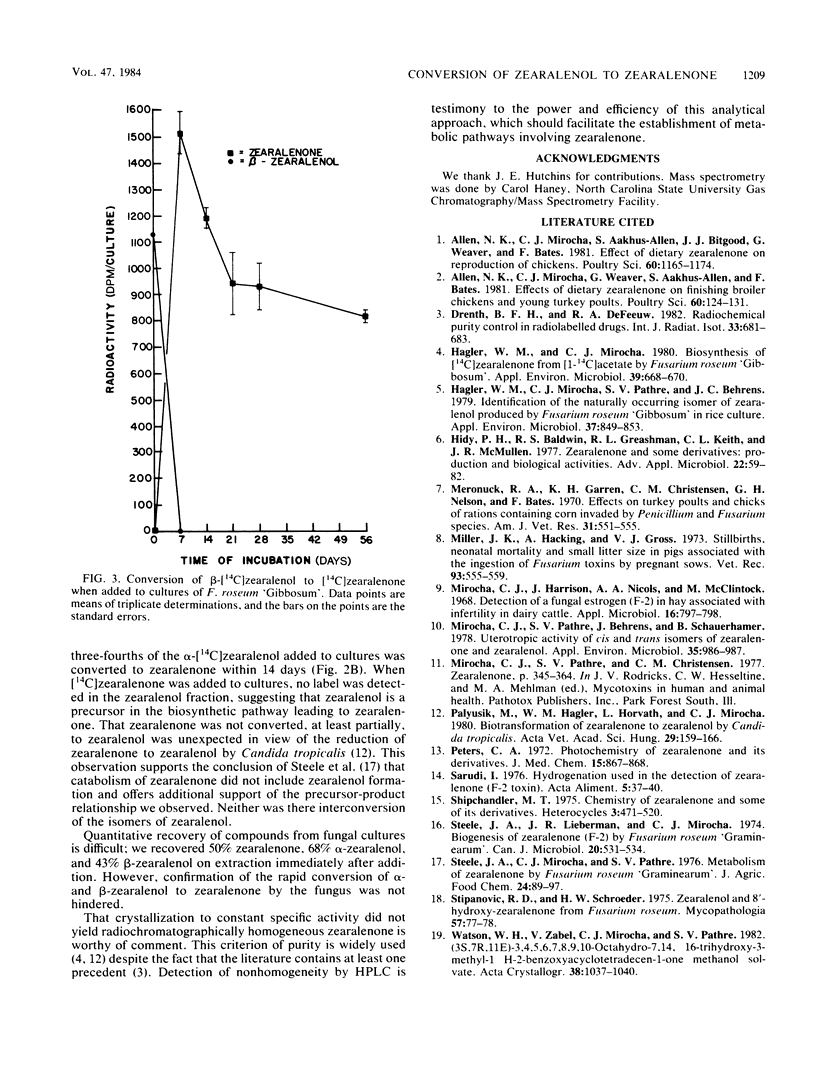Abstract
Cultures of Fusarium roseium 'Gibbosum' on rice were treated with [14C]zearalenone, alpha[14C]zearalenol, or beta-[14C]zearalenol to determine whether a precursor-product relationship exists among these closely related fungal metabolites. Culture extracts were purified by silica gel column chromatography and fractionated by high-pressure liquid chromatography, and the level of radioactivity was determined. Within 7 days, the beta-[14C]zearalenol was converted to zearalenone, and no residual beta-[14C]zearalenol was detectable. Most of the alpha-[14C]zearalenol added was also converted into zearalenone with 14 days. In cultures treated with [14C]zearalenone, no radioactivity was noted in any other components.
Full text
PDF



Selected References
These references are in PubMed. This may not be the complete list of references from this article.
- Allen N. K., Mirocha C. J., Aakhus-Allen S., Bitgood J. J., Weaver G., Bates F. Effect of dietary zearalenone on reproduction of chickens. Poult Sci. 1981 Jun;60(6):1165–1174. doi: 10.3382/ps.0601165. [DOI] [PubMed] [Google Scholar]
- Allen N. K., Mirocha C. J., Weaver G., Aakhus-Allen S., Bates F. Effects of dietary zearalenone on finishing broiler chickens and young turkey poults. Poult Sci. 1981 Jan;60(1):124–131. doi: 10.3382/ps.0600124. [DOI] [PubMed] [Google Scholar]
- Drenth B. F., De Zeeuw R. A. Radiochemical purity control of radiolabeled drugs. Int J Appl Radiat Isot. 1982 Aug;33(8):681–683. doi: 10.1016/0020-708x(82)90070-9. [DOI] [PubMed] [Google Scholar]
- Hagler W. M., Mirocha C. J. Biosynthesis of [14C]zearalenone from [1-14C]acetate by Fusarium roseum 'Gibbosum'. Appl Environ Microbiol. 1980 Mar;39(3):668–670. doi: 10.1128/aem.39.3.668-670.1980. [DOI] [PMC free article] [PubMed] [Google Scholar]
- Hagler W. M., Mirocha C. J., Pathre S. V., Behrens J. C. Identification of the naturally occurring isomer of zearalenol produced by Fusarium roseum 'Gibbosum' in rice culture. Appl Environ Microbiol. 1979 May;37(5):849–853. doi: 10.1128/aem.37.5.849-853.1979. [DOI] [PMC free article] [PubMed] [Google Scholar]
- Hidy P. H., Baldwin R. S., Greasham R. L., Keith C. L., McMullen J. R. Zearalenone and some derivatives: production and biological activities. Adv Appl Microbiol. 1977;22:59–82. doi: 10.1016/s0065-2164(08)70160-6. [DOI] [PubMed] [Google Scholar]
- Meronuck R. A., Garren K. H., Christensen C. M., Nelson G. H., Bates F. Effects on turkey poults and chicks of rations containing corn invaded by Penicillium and Fusarium species. Am J Vet Res. 1970 Mar;31(3):551–555. [PubMed] [Google Scholar]
- Miller J. K., Hacking A., Harrison J., Gross V. J. Stillbirths, neonatal mortality and small litters in pigs associated with the ingestion of Fusarium toxin by pregnant sows. Vet Rec. 1973 Nov 24;93(21):555–559. doi: 10.1136/vr.93.21.555. [DOI] [PubMed] [Google Scholar]
- Mirocha C. J., Harrison J., Nichols A. A., McClintock M. Detection of a fungal estrogen (F-2) in hay associated with infertility in dairy cattle. Appl Microbiol. 1968 May;16(5):797–798. doi: 10.1128/am.16.5.797-798.1968. [DOI] [PMC free article] [PubMed] [Google Scholar]
- Mirocha C. J., Pathre S. V., Behrens J., Schauerhamer B. Uterotropic activity of cis and trans isomers of zearalenone and zearalenol. Appl Environ Microbiol. 1978 May;35(5):986–987. doi: 10.1128/aem.35.5.986-987.1978. [DOI] [PMC free article] [PubMed] [Google Scholar]
- Palyusik M., Hagler W. M., Horváth L., Mirocha C. J. Biotransformation of zearalenone to zearalenol by Candida tropicalis. Acta Vet Acad Sci Hung. 1980;28(2):159–166. [PubMed] [Google Scholar]
- Peters C. A. Photochemistry of zearalenone and its derivatives. J Med Chem. 1972 Aug;15(8):867–868. doi: 10.1021/jm00278a028. [DOI] [PubMed] [Google Scholar]
- Steel J. A., Lieberman J. R., Mirocha C. J. Biogenesis of zearalenone (F-2) by Fusarium roseum 'Graminearum'. Can J Microbiol. 1974 Apr;20(4):531–534. doi: 10.1139/m74-081. [DOI] [PubMed] [Google Scholar]
- Steele J. A., Mirocha C. J., Pathre S. V. Metabolism of zearalenone by Fusarium roseum Graminearum. J Agric Food Chem. 1976 Jan-Feb;24(1):89–97. doi: 10.1021/jf60203a001. [DOI] [PubMed] [Google Scholar]
- Stipanovic R. D., Schroeder H. W. Zearalenol and 8'-hydroxyzearalenone from Fusarium roseum. Mycopathologia. 1975 Dec 23;57(2):77–78. doi: 10.1007/BF01365707. [DOI] [PubMed] [Google Scholar]


